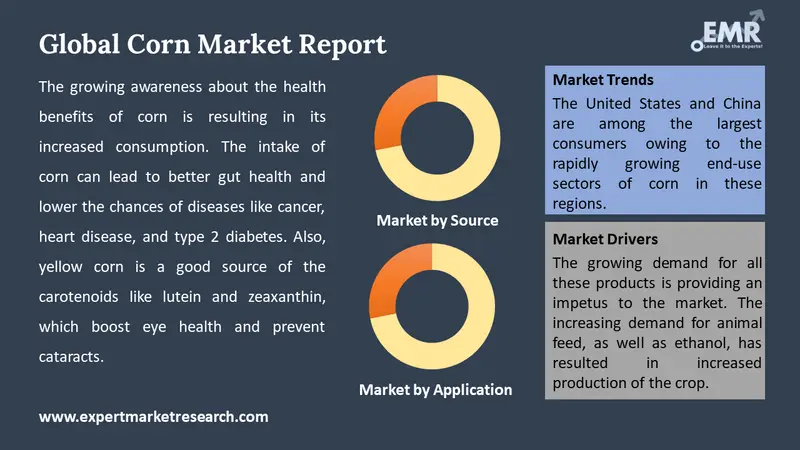
Consumer Insights
Uncover trends and behaviors shaping consumer choices today
Procurement Insights
Optimize your sourcing strategy with key market data
Industry Stats
Stay ahead with the latest trends and market analysis.
Trending Now



The global corn market reached a volume of 1183.43 MMT in 2024. The market is projected to grow at a CAGR of 1.10% between 2025 and 2034, to reach a volume of around 1320.24 MMT by 2034.
Base Year
Historical Year
Forecast Year






Value in MMT
2025-2034
Corn Market Outlook
*this image is indicative*
Corn is the staple food in many parts of the world and serves as a primary food source for humans and livestock aside from serving as raw material in many sectors. Corn is remarkable in its productivity and the wide variety of uses it has. It can be eaten as a vegetable while still young or after harvest when mature and thus used as a grain.
It is one of the basic constituents of corn syrup, cornstarch, popcorn, and many other food and industrial products. Corn is genetically quite variable, thus allowing it to grow in a wide variety of climatic conditions and under both intensive and extensive agriculture methods. Corn is one of the major food sources, but it also stands prominent in economies in agriculture and food industries.
In 2023, Breeder Direct has introduced two new corn hybrids. The Contend Series of hybrids is meant to provide consistent performance in hard circumstances, whereas the Command Series is an exclusive line developed for improved growing conditions. The development of both the Contend as well as Command series of corn hybrids provides seed firms alternatives that result in profitability on every acre, regardless of yield potential.
Economic growth in developing countries could result in an increased demand for corn and corn-based products and by-products. With a growing population comes a growing need for food, including corn. It is a critical component of animal feed, which enhances the demand for corn globally. A significant trend of corn market is the growing population which results in increased demand for direct human consumption and indirect consumption of meat and dairy products.
In countries with developing economies, economic growth tends to result in larger disposable incomes, which then are converted into changes in diets. There's usually an increase in the consumption of meat and dairy products, whereby this increases demand for corn as animal feed. Higher economic conditions, on the other hand, normally translate to increased utilization of corn-based products and by-products.
Advances in agricultural technology
Advances in genetic engineering are one of the key corn market trends, which have resulted in the production of corn variants that are more pest- and disease-resistant, heterogeneous, and withstand challenging weather conditions. Gene editing with CRISPR is now enabling changes that allow crops to become more drought-resistant, with efficient rates of nutrient uptake and growth. Genomic data is also speeding up traditional breeding for the development of new varieties that are more resilient to various stresses, aiding the corn demand forecast. Farmers will be able to use precision agriculture to tailor their practices to the needs of different areas of their fields, this therefore maximizes the output of the resources. This also involves precise quantities and times of application of water, fertilizers, and pesticides. This increases production but reduces the environmental impact.
Trade policies and agreements between major corn-producing and –consuming countries
The reduction in tariffs and other trade barriers on corn will catalyze the corn industry revenue as the exporting countries can sell more corn in the global market. This increased accessibility can lead to a rise in exports, benefiting major corn-producing countries.
Bilateral and multilateral trade agreements can create more favorable conditions for corn trade. For example, agreements that include provisions for agricultural products can open up new markets for corn exporters, boosting global trade volumes. Policies that promote sustainable and ethical farming practices can also impact the corn market. Consumers and businesses are increasingly demanding environmentally friendly and socially responsible products, which can shape trade flows and market preferences.
According to the Food and Agriculture Organization of the United Nations (2023), in 2021, the United States led global corn production with 382.89 million tons, representing a significant increase from 2018's 364.26 million tons. Despite a slight decline to 358.45 million tons in 2020, the upward trajectory resumed, reaching 348.75 million tons in 2022.
China's corn market value is boosted by its production that exhibited a steady increase from 257.17 million tons in 2018 to 277.20 million tons in 2022. Notably, 2021 saw a sharp rise to 272.55 million tons from 260.78 million tons in 2019, marking the highest annual growth within the observed period. By 2022, China's production had increased by nearly 20 million tons compared to 2018.
Russia's corn production, while significantly lower in volume compared to the other nations, also showed progressive growth. From 11.42 million tons in 2018, production rose to 15.86 million tons by 2022. This upward trend, particularly noticeable from 14.28 million tons in 2019 to 15.86 million tons in 2022, signifies improvements in Russian agricultural efficiency and capacity.
According to the Federal Reserve Bank of St. Louis, From 2018 to 2023, global corn prices exhibited significant fluctuations. Starting at USD 164.51 per metric ton in 2018, prices saw a modest rise to USD 170.17 in 2019, followed by a slight dip to USD 165.58 in 2020. Prices saw a sharp rise in 2021, rising to USD 259.39 per metric ton—nearly $100 more than the previous year.
The upward trend persisted in 2022, reaching a peak of USD 318.36 per metric ton, or almost double the price of 2018. Even with the decline to USD 251.46 per metric ton in 2023, it was still much higher than in 2021. These variations highlight how interruptions to the world's supply chains, geopolitical unrest, and shifts in demand affect corn prices.
India's corn production demonstrated a more modest yet consistent growth pattern. Starting at 28.75 million tons in 2018, the production increased to 33.73 million tons in 2022. The incremental growth, particularly from 27.72 million tons in 2019 to 31.65 million tons in 2021.
Government initiatives aimed at boosting maize production are therefore driving the market revenues. For example, in May 2023, the Indian government announced that it would increase maize production and would engage farmers to do so through various initiatives given the demand coming from a host of industries, such as the ethanol and poultry production industries. It is projected to continue benefiting from the research and development being done towards increasing corn production and maximizing profit in the corn industry in India during the forecast period.

Read more about this report - REQUEST FREE SAMPLE COPY IN PDF
The EMR’s report titled “Corn Market Report and Forecast 2025-2034” offers a detailed analysis of the market based on the following segments:
The corn market is bifurcated based on source into:
Corn finds its applications in the following segments:
Market breakup by region:
The market is being stimulated by the increasing demand for corn in the animal food and feed industry. The crop's production has increased because of an increase in ethanol and animal feedstock demand. Corn, having high starch content and being easily convertible into ethanol, finds its major application in producing biofuel.
As per corn industry analysis, the market is growing due to an increase in demand forecast for one of its end-use products, which is sorbitol. Among those who are health-conscious, sorbitol is often utilized because of its low-calorie content. Pharmaceuticals and personal care items both use sorbitol extensively. The corn industry is also being driven by the product's easy availability and inexpensive cost of manufacturing.
The growth of the industry, particularly in the Asia Pacific area, has been encouraged by the government's favorable policies and the rising FDI flows into both pharmaceutical and personal care products. In the Asia Pacific region, China and India are the product's two main emerging markets.
Corn is being consumed more often due to improved knowledge about its health benefits. Intake of corn helps in the improvement of gut health and reduces the risk of illnesses such as heart disease, cancer, and type 2 diabetes. Yellow corn also contains high amounts of carotenoids, such as zeaxanthin and lutein, which enhance eye health and prevent cataracts. Rising production, particularly in South Asian countries, due to geographical and climatic conditions, remains one of the major factors driving corn demand growth.
Increasing corn production in countries like China and the United States to Bolster Sales
The three main corn-producing nations are the United States, China, and Brazil; the United States accounts for around 36% of the global market share for corn. The other main exporters of the crop are Russia, Argentina, Brazil, and Ukraine, which together account for more than 36% of global exports.
China, the United States, Mexico, the European Union, and Brazil are the main corn-consuming markets, boosting the growth of the corn market. The end-use industries, such as the markets for corn starch and animal feed, contribute to the increasing demand in these areas. Due to the constantly expanding end-use industries of corn in these regions, the United States and China rank among the major consumers. Japan, Mexico, South Korea, and the European Union are among the nations that depend on imports.
The growth of the feed and industrial sectors is the cause of the increased demand for corn within the United States. Since corn contains carbohydrates, it makes up a useful part of a livestock's diet. Animal feed is the nation's most common application sector, next to fuel ethanol. China is the primary producer of corn, therefore the country's expanding processing industry is fueling corn market revenue. The nation possesses a noteworthy portion of the market in various application domains such as polyols and HFCS.
Production has risen sharply, especially in major producing countries, particularly the United States, which is enjoying favorable weather and higher yields. New agricultural technologies aimed at boosting yields, such as precision farming and higher yielding, genetically engineered varieties, are underway to boost output efficiency and robustness. Extreme and variable weather due to climate change can hit yields and thus supply and price volatility. The surging corn demand in the making of biofuel, primarily ethanol, continues to diminish the real value of corn and further integrates it with the energy sector.
There could be further focus on sustainable modes of corn production that balance high yields with environmental and social duties. Trade policy, international relationships, and geopolitical events can be huge drivers of global trade flows and pricing in the corn industry.
*While we strive to always give you current and accurate information, the numbers depicted on the website are indicative and may differ from the actual numbers in the main report. At Expert Market Research, we aim to bring you the latest insights and trends in the market. Using our analyses and forecasts, stakeholders can understand the market dynamics, navigate challenges, and capitalize on opportunities to make data-driven strategic decisions.*
Get in touch with us for a customized solution tailored to your unique requirements and save upto 35%!
In 2024, the corn market reached an approximate volume of 1183.43 MMT.
The market is projected to grow at a CAGR of 1.10% between 2025 and 2034.
The market is being driven by the growing demand for sorbitol and the rising use of corn in end-use industries, such as personal care and pharmaceuticals, among others.
The key trends guiding the market include the rising demand for corn in the animal feed sector and the growing uses of corn as ethanol fuel.
The major regions in the industry are North America, Latin America, the Middle East and Africa, Europe, and the Asia Pacific.
The significant applications of corn include food and beverages, animal feed, and ethanol production, among others.
The major sources of corn are organic and conventional.
The market is estimated to witness healthy growth in the forecast period of 2025-2034 to reach a volume of around 1320.24 MMT by 2034.
Explore our key highlights of the report and gain a concise overview of key findings, trends, and actionable insights that will empower your strategic decisions.
| Report Features | Details |
| Base Year | 2024 |
| Historical Period | 2018-2024 |
| Forecast Period | 2025-2034 |
| Scope of the Report |
Historical and Forecast Trends, Industry Drivers and Constraints, Historical and Forecast Market Analysis by Segment:
|
| Breakup by Source |
|
| Breakup by Application |
|
| Breakup by Region |
|
| Market Dynamics |
|
| Trade Data Analysis |
|
Datasheet
One User
USD 2,499
USD 2,249
tax inclusive*
Single User License
One User
USD 3,999
USD 3,599
tax inclusive*
Five User License
Five User
USD 4,999
USD 4,249
tax inclusive*
Corporate License
Unlimited Users
USD 5,999
USD 5,099
tax inclusive*
*Please note that the prices mentioned below are starting prices for each bundle type. Kindly contact our team for further details.*
Flash Bundle
Small Business Bundle
Growth Bundle
Enterprise Bundle
*Please note that the prices mentioned below are starting prices for each bundle type. Kindly contact our team for further details.*
Flash Bundle
Number of Reports: 3
20%
tax inclusive*
Small Business Bundle
Number of Reports: 5
25%
tax inclusive*
Growth Bundle
Number of Reports: 8
30%
tax inclusive*
Enterprise Bundle
Number of Reports: 10
35%
tax inclusive*
How To Order
Our step-by-step guide will help you select, purchase, and access your reports swiftly, ensuring you get the information that drives your decisions, right when you need it.

Select License Type
Choose the right license for your needs and access rights.

Click on ‘Buy Now’
Add the report to your cart with one click and proceed to register.

Select Mode of Payment
Choose a payment option for a secure checkout. You will be redirected accordingly.
Track prices with detailed trend reports.

Analyse trade data for supply chain insights.

Leverage cost reports for smart savings

Enhance supply chain with partnerships.

Gain insights to stay ahead and seize opportunities.

Get insights & trends for a competitive edge.

Track prices with detailed trend reports.

Analyse trade data for supply chain insights.

Leverage cost reports for smart savings

Enhance supply chain with partnerships.

Gain insights to stay ahead and seize opportunities.

Get insights & trends for a competitive edge.

Track prices with detailed trend reports.

Analyse trade data for supply chain insights.

Connect For More Information
Our expert team of analysts will offer full support and resolve any queries regarding the report, before and after the purchase.
Our expert team of analysts will offer full support and resolve any queries regarding the report, before and after the purchase.
We employ meticulous research methods, blending advanced analytics and expert insights to deliver accurate, actionable industry intelligence, staying ahead of competitors.
Our skilled analysts offer unparalleled competitive advantage with detailed insights on current and emerging markets, ensuring your strategic edge.
We offer an in-depth yet simplified presentation of industry insights and analysis to meet your specific requirements effectively.



Australia
63 Fiona Drive, Tamworth, NSW
+61-448-061-727
India
C130 Sector 2 Noida, Uttar Pradesh 201301
+91-723-689-1189
Philippines
40th Floor, PBCom Tower, 6795 Ayala Avenue Cor V.A Rufino St. Makati City,1226.
+63-287-899-028, +63-967-048-3306
United Kingdom
6 Gardner Place, Becketts Close, Feltham TW14 0BX, Greater London
+44-753-713-2163
United States
30 North Gould Street, Sheridan, WY 82801
+1-415-325-5166
Vietnam
193/26/4 St.no.6, Ward Binh Hung Hoa, Binh Tan District, Ho Chi Minh City
+84-865-399-124
United States (Head Office)
30 North Gould Street, Sheridan, WY 82801
+1-415-325-5166
Australia
63 Fiona Drive, Tamworth, NSW
+61-448-061-727
India
C130 Sector 2 Noida, Uttar Pradesh 201301
+91-723-689-1189
Philippines
40th Floor, PBCom Tower, 6795 Ayala Avenue Cor V.A Rufino St. Makati City, 1226.
+63-287-899-028, +63-967-048-3306
United Kingdom
6 Gardner Place, Becketts Close, Feltham TW14 0BX, Greater London
+44-753-713-2163
Vietnam
193/26/4 St.no.6, Ward Binh Hung Hoa, Binh Tan District, Ho Chi Minh City
+84-865-399-124
Share